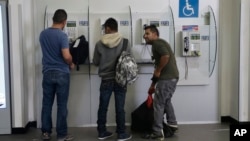President Donald Trump has made headlines with his swift action on immigration and vows to deport those living in the U.S. illegally who have a criminal past. Now any immigrant charged or convicted of any offense, or even suspected of a crime, has become an enforcement priority for federal authorities.
The stricter policy has brought new attention to a labyrinth of an immigration system where simply deporting someone is never a simple or time-efficient task. Months, if not years, can pass. In the end, if the case is lost, the immigrant may find him or herself on a bus or plane heading back to his or her home country.
But what exactly happens between the time someone is taken into custody and when they leave the U.S.? Some basics on the court and deportation process:
EXPEDITED REMOVALS
Under current policies, immigrants who are detained within 100 miles of the border and who have been in the country less than 14 days can be deported immediately, without being processed through the immigration courts. If an individual caught along the border makes a claim for asylum, he or she will have their claim reviewed by an asylum officer with U.S. Citizenship and Immigration Services. If the claim is approved, the individual goes through the immigration court process. If not approved, that person joins the other immigrants caught along the border who are usually immediately returned to their home countries, often within a few days, either by bus or plane.
Homeland Security Secretary John Kelly has suggested expanding the expedited removal rule to immigrants in the country illegally who can't prove they've been living in the U.S. continuously for at least two years.
IMMIGRATION COURT
The first step in immigration court is a preliminary hearing, during which a judge considers any claims to asylum or other requests to cancel the deportation, said Stephen Legomsky, a former senior counselor to previous Homeland Security Secretary Jeh Johnson. If the case can't be resolved quickly, the judge schedules a full-hearing date. Immigrants can ask the judge if they can be released on bond while their case is pending.
"The (individual) hearing itself is a little bit like a trial, where each side can present evidence and witnesses," said Legomsky, who is now an emeritus professor of law at Washington University in St. Louis.
But months or even years could pass before the full hearing takes place. According to the Executive Office for Immigration Review, more than 534,000 cases, including deportations, asylum applications and bond reviews, are currently pending on immigration court dockets nationwide.
Because immigration court hearings are civil proceedings, immigrants are not guaranteed legal representation, notes Angelique Montano, an immigration attorney at the Quan Law Group in Houston.
APPEALS PROCESS
The immigration judge usually makes a ruling at the conclusion of an individual hearing. Either side can appeal a ruling not in their favor to the Virginia-based Board of Immigration Appeals, part of the U.S. Department of Justice. Some common grounds for appeal can include arguing the immigration judge misinterpreted the law or evidence was not reviewed properly.
"That can add on four months or more to the case," Montano said.
All immigrants, including those who were allowed out on bond while their cases were pending, will be held in custody until their appeals are resolved.
The appeals court's decision is usually final, but in some situations, the case can be reviewed by the U.S. Court of Appeals that has jurisdiction over the state where the removal proceedings took place, Legomsky said.
RETURN TO HOME COUNTRY
Once all appeals are exhausted, deportation by U.S. Immigration and Customs Enforcement, or ICE, may take several days or several weeks, depending on what country an immigrant is from. Difficulty in obtaining the required travel documents from the home country could cause additional delays.
ICE Air Operations uses commercial and charter flights to deport immigrants.
Mexican immigrants ordered removed from the United States travel on domestic flights to cities along the border such as San Diego and Brownsville, Texas, according to ICE. Immigration officials then bus them to the U.S.-Mexico border. Sometimes the immigrants are bused across the border and sometimes officials watch them walk across back to Mexico.
In cities closer to the U.S.-Mexico border, immigrants from Mexico are usually transported by bus to the border because it's more cost effective than transporting them by plane, said ICE spokesman Greg Palmore.
Immigrants from Central and South America and the Caribbean are usually flown on charter flights, according to ICE. Charter flights are also scheduled as needed for immigrants being returned to Europe, Africa and Asia. According to a 2015 report by Homeland Security's Office of Inspector General, ICE Air Operations paid an average of $8,419 per flight hour for these various charter flights.
In fiscal year 2016, ICE deported individuals from 185 countries. Most were from Mexico (149,821), followed by Guatemala (33,940) and Honduras (21,994).
IMMIGRANTS CHARGED WITH CRIMES
Immigrants who are determined to be in the country illegally after being arrested for a crime usually must complete their sentences before ICE takes them into custody on immigration charges.








